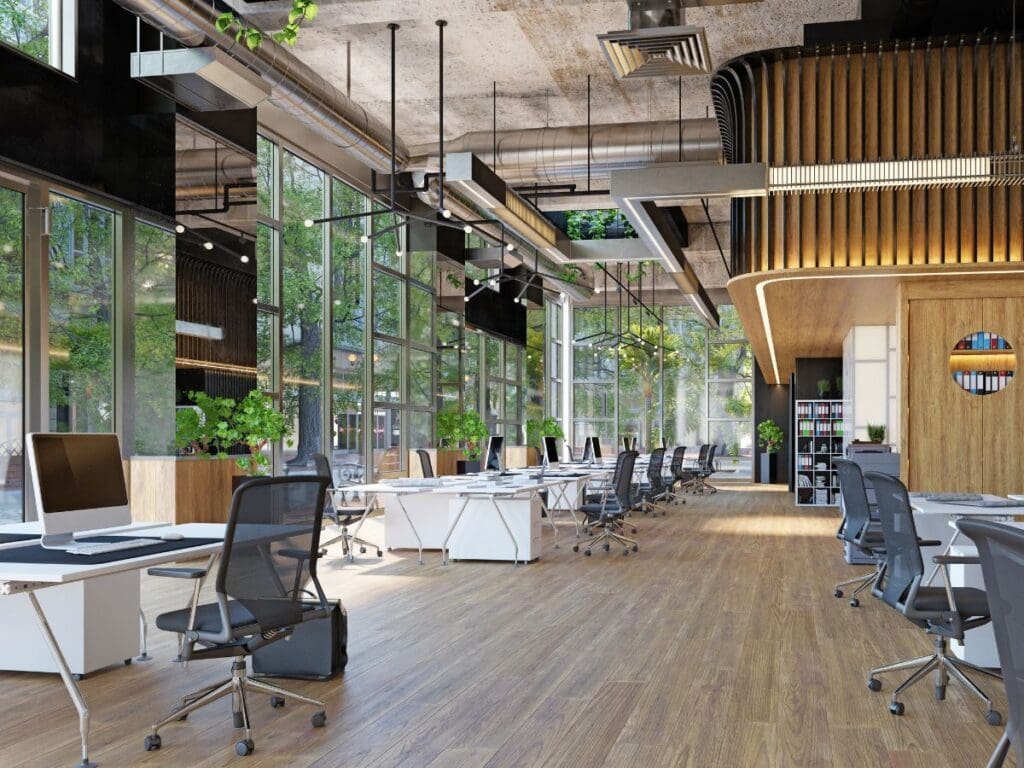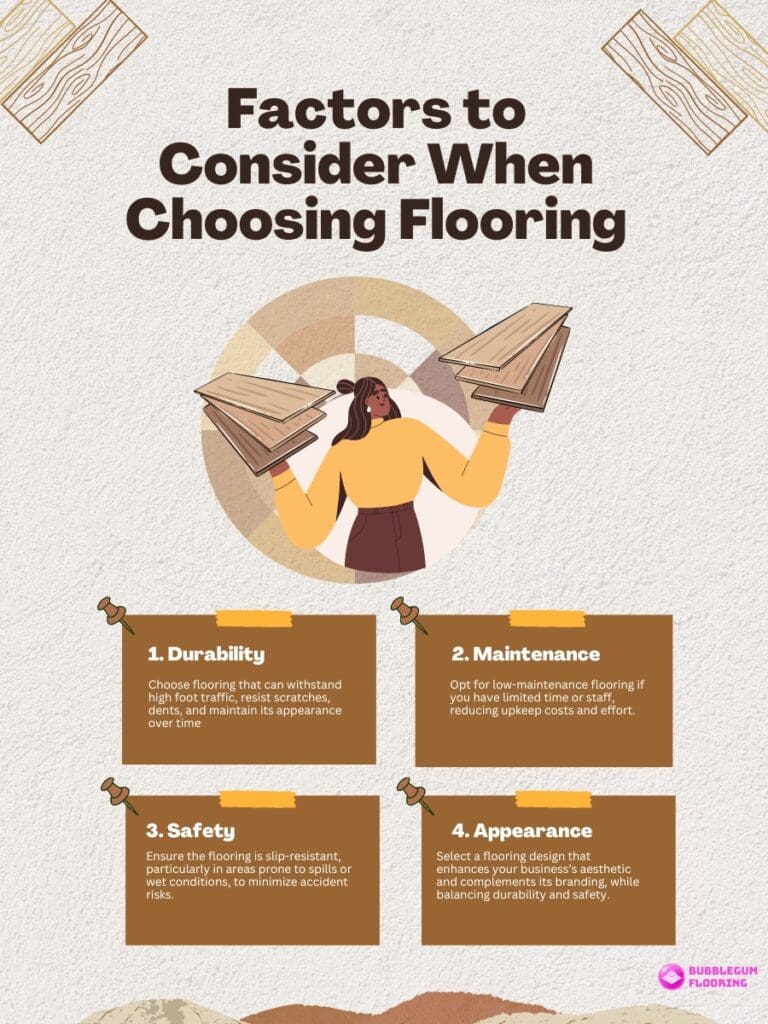When you’re managing a business, every detail matters, especially the surfaces people walk on daily. Whether it’s customers streaming through your doors or employees moving through workspaces, the right flooring is important in maintaining a safe, attractive, and durable environment.
High-traffic areas demand more than just any flooring—they need solutions that can handle the daily wear and tear without compromising on safety or appearance. Think about it: the floors in your business are one of the first things people notice when they walk in.
If they look worn or damaged, it can create a negative impression, affecting how people perceive your entire business. On the flip side, choosing the right durable flooring can enhance your space, making it not only more appealing but also more functional. Let’s look at flooring for high-traffic areas.
High-Traffic Flooring Needs
When you’re deciding on flooring for your business, it’s important to understand what “high-traffic” really means in your specific environment. High-traffic areas are places where people are constantly moving—think of the bustling entryways of a retail store, the busy corridors of an office building, or the active common areas in a restaurant.
These spaces experience a lot more wear and tear than other parts of your business, so the flooring needs to be robust and resilient. You want your flooring to stand up to everything from heavy footfall to the occasional spill or dropped item.
What Qualifies as a High-Traffic Area?
High-traffic areas are those parts of your business where movement is constant. These are the spaces where people naturally gather or pass through regularly, such as entrances, hallways, lobbies, and communal workspaces.
Because these areas are used so frequently, they require flooring that can handle the pressure without showing signs of wear quickly. In these high-traffic zones, the flooring must not only be durable but also easy to maintain.
With so many people walking over it daily, you’ll need a solution that can be cleaned easily and won’t require frequent repairs or replacements. It’s about choosing a material that can handle the stress and still look good after years of use.
Unique Challenges in High-Traffic Areas
High-traffic areas in businesses come with their own set of challenges. The constant movement means your flooring will face more wear and tear than in other parts of your space.
This can lead to issues like scuff marks, scratches, and even more serious damage if the flooring material isn’t up to the task. But it’s not just about durability; these areas also need to be safe for everyone who walks on them.
Safety is a major concern in high-traffic areas. Slips and falls are more likely to happen where there’s a lot of movement, especially if the flooring becomes worn or slick over time.
Top Durable Flooring Options for High-Traffic Areas
Choosing the right flooring for your business, especially in high-traffic areas, is all about finding the perfect balance between durability, maintenance, and overall appearance. The options available today offer a wide range of benefits, catering to different needs and preferences.
It’s important to consider not only how the flooring looks but also how it performs over time. The materials you choose will need to endure daily use, resist damage, and still look good after years of wear.
1. Concrete
Concrete is one of the most durable flooring options available for high-traffic areas. It’s tough, long-lasting, and can withstand the heavy use common in commercial spaces like warehouses, retail stores, and office buildings.

Concrete floors are also relatively low maintenance, requiring only occasional sealing and cleaning to keep them in good condition. Concrete offers a sleek and modern look that can be customized with various finishes, stains, or polishes to suit your business’s style.
2. Luxury Vinyl Tile (LVT)
Luxury Vinyl Tile (LVT) is another excellent option for high-traffic areas. It combines durability with a wide range of design options, mimicking the look of natural materials like wood or stone at a fraction of the cost.

LVT is resilient, easy to clean, and resistant to moisture, making it ideal for environments like offices, retail spaces, and restaurants. It has an ability to absorb sound, which can be particularly useful in busy areas where noise levels need to be controlled.
LVT is softer underfoot compared to other hard flooring options, providing comfort for those who spend long hours on their feet.
3. Epoxy Flooring
Epoxy flooring is known for its incredible strength and resistance to heavy traffic. Often used in industrial settings, garages, and commercial kitchens, epoxy floors are highly durable and can handle the weight of heavy equipment, frequent foot traffic, and even chemical spills.

The seamless nature of epoxy flooring makes it easy to clean, with no joints or seams where dirt and grime can accumulate. Epoxy flooring also offers a high-gloss finish that can brighten up a space, making it look clean and professional.
With the ability to add color, patterns, or even company logos to the floor, epoxy flooring can be customized to enhance the branding and overall look of your business space.
4. Ceramic and Porcelain Tile
Ceramic and porcelain tiles are classic choices for high-traffic areas, known for their durability and ease of maintenance. These tiles are incredibly strong and resistant to scratches, stains, and moisture, making them suitable for areas like lobbies, restrooms, and dining areas.

They also come in a wide variety of colors, patterns, and textures, allowing you to create a customized look that matches your business’s style. Ceramic and porcelain tiles are easy to clean, requiring just regular sweeping and mopping to maintain their appearance.
They are also a great option for businesses in warmer climates, as they stay cool underfoot, providing comfort to customers and employees alike.
5. Rubber Flooring
Rubber flooring is an excellent choice for high-traffic areas where safety and comfort are top priorities. It’s commonly used in gyms, healthcare facilities, and schools due to its shock-absorbing properties, slip resistance, and ease of maintenance.

Rubber flooring is durable, resistant to wear, and can handle the constant foot traffic typical of busy commercial spaces. What sets rubber flooring apart is its ability to reduce noise and provide a cushioned surface, making it more comfortable for people who spend long periods standing or walking.
It also comes in various colors and patterns, allowing you to choose a design that complements your business environment while enjoying the practical benefits it offers.
Factors to Consider When Choosing Flooring
When it comes to selecting the right flooring for high-traffic areas in your business, it’s not just about picking the toughest material. Your decision should balance these elements to ensure you get the best value and functionality for your business environment.
You’ll want to think about the long-term implications of your choice. Flooring is an investment, and making the right decision upfront can save you from unnecessary headaches down the line.

1. Durability
The flooring you choose needs to withstand the constant pressure of foot traffic, furniture movement, and whatever else your business throws at it. Some materials are inherently more durable than others, and it’s essential to select one that matches the demands of your specific environment.
It’s not just about how long the flooring lasts, but also how well it maintains its appearance over time. High-traffic areas are prone to wear and tear, and choosing a material that can resist scratches, dents, and other forms of damage is crucial.
2. Maintenance
The easier it is to clean and maintain your floors, the less time and money you’ll spend on upkeep. Some flooring materials require regular sealing, polishing, or special cleaning solutions, while others are more low-maintenance, needing only occasional sweeping and mopping.
You’ll want to choose a flooring option that aligns with your business’s maintenance capabilities. For example, if you have a busy schedule and minimal staff, opting for a low-maintenance floor might be the best choice.
3. Safety
The right flooring material can help minimize the risk of accidents, providing better traction and reducing the chance of injuries. This is particularly important in environments where spills are common, or where the flooring may become wet or slick.
When evaluating flooring options, consider how slip-resistant the material is and whether it can maintain that grip even in less-than-ideal conditions. Think about how the flooring will behave over time; materials that become slick as they wear down could pose a safety hazard down the line.
4. Appearance
The right flooring can enhance the overall look of your business, contributing to a professional and welcoming atmosphere. It’s essential to choose a material and design that complements your business’s style and branding, creating a cohesive look throughout your space.
However, appearance shouldn’t come at the expense of other factors like durability and safety. It’s possible to find flooring that looks great and performs well, but it may require a bit more research and investment.
5. Cost
While some flooring options may have a higher upfront cost, they could save you money in the long run through lower maintenance requirements, longer lifespan, and fewer repairs. On the other hand, cheaper options might require frequent replacement or upkeep, ultimately costing you more over time.
| Flooring Option | Initial Cost | Maintenance Cost (Annual) | Lifespan | Total Cost Over 10 Years |
| Concrete | $$ | $ | 20+ years | $$$ |
| Luxury Vinyl Tile (LVT) | $$ | $$ | 10-20 years | $$$$ |
| Epoxy Flooring | $$$ | $ | 10-15 years | $$$$ |
| Ceramic/Porcelain Tile | $$$ | $$ | 20+ years | $$$$$ |
| Rubber Flooring | $$ | $$ | 10-15 years | $$$$ |
Key:
- $: Low cost
- $$: Moderate cost
- $$$: High cost
- $$$$: Very high cost
Note: These are approximate values and can vary depending on the specific materials chosen, installation costs, and regional price differences. When evaluating cost, consider not just the price of the materials, but also installation costs, maintenance expenses, and the potential need for future repairs.
Flooring Maintenance Hacks for Busy Homeowners
Choosing the right flooring for your business’s high-traffic areas is about more than just picking a material that looks good. It’s about finding a solution that can handle the daily wear and tear, requires minimal maintenance, and keeps everyone safe while still fitting within your budget.
For busy homeowners, the same principles apply when selecting flooring for high-traffic areas in their homes. Maintenance hacks can help you keep your flooring in top condition with minimal effort, ensuring it lasts longer and continues to look great despite heavy use.
Whether in a commercial setting or at home, understanding how to maintain your floors efficiently can make all the difference in preserving their quality and appearance.


